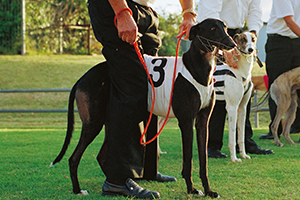
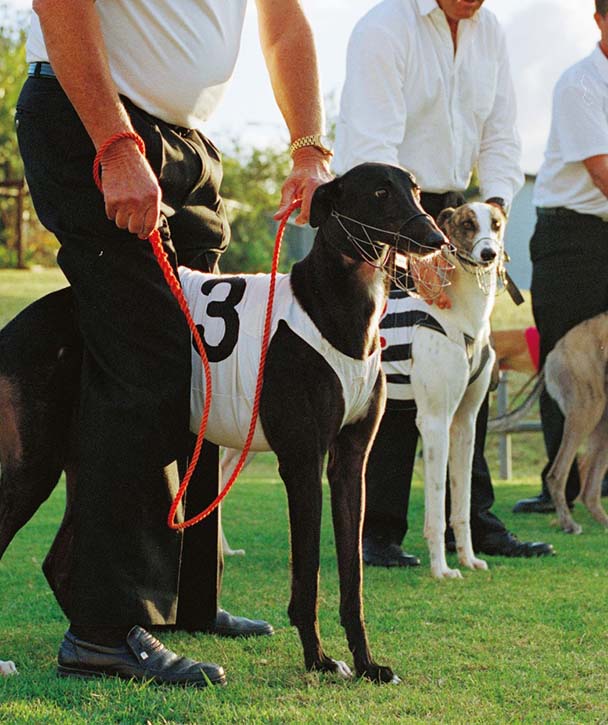
Can Greyhound Racing Survive?
With damning reports of injury and doping, a once-fashionable sport is officially on notice.
By Mirjam Guesgen
It’s mid-morning in the rural Manawatū. Gary Fredrickson is strolling through a gravel carpark adorned with a regal-looking wooden greyhound statue, a bounding black dog in tow. He’s a little puffed — his breath clouding the morning air — and so is the dog. “We’re running the pups this morning,” he says as he moves inside a small building, past a warren of dog toys, a table with bowls containing raw meat seasoned with supplements and kibble, and a cabinet of medical supplies, to a room with about eight kennels full of barking greyhounds. Fredrickson puts the black dog in one kennel, where he proceeds to gulp water from his bowl, and takes another out.
He heads back outside towards a long stretch of sand enclosed on all sides by green netting. A makeshift raceway. Fredrickson leads the dog, Toby, to a metal starting box about the size of a large suitcase and gently coaxes him in.
With a quiet, metallic thud, the door of the box springs open and Toby bursts forth, chasing after a plastic bag and stuffed toy tied on to a retractable cable. When he reaches the other end, roughly 100 metres away, I see Toby goofing off with his spoils. “Nailed it. Beautiful out of there,” Fredrickson says.
It keeps going like this for about half an hour, with dogs led in one at a time for a couple of runs each. For most of the pups, this is only their second time in the starting boxes. They’ve never seen a race track. In fact, they’ve never even left the area around Fredrickson’s property.
Fredrickson works well in excess of 70 hours a week training and looking after his dogs. This is what greyhound racing is. It’s a side to the sport the public rarely sees.
The part they do see, sleek animals hurtling round the track, makes up about 14 minutes total of the dogs’ 10-to-14-year life, with each dog racing about 35 times in its short career and each race taking about 24 seconds of intense effort. Those 14 minutes can be fraught with injury: scrapes, bruises, broken bones. Because of the speed at which the dogs run, and the sometimes unstable conditions of the track, injuries are almost inevitable. In the worst cases, dogs will hurt themselves so badly they need to be euthanised. And it’s not just accidents on the track which pose a threat to the dogs’ health — dogs have known to be doped with performance enhancers including caffeine and methamphetamine.
Late last month, greyhound racing at Hatrick Raceway in Whanganui was suspended indefinitely pending an investigation by Greyhound Racing New Zealand (GRNZ), after six dogs were injured during a single race meeting. Three had broken bones, two had suspected fractures and one suffered a torn tricep. Earlier this year, it was reported that nine dogs had died at Hatrick in as many months, leading animal rights group SAFE to call it a “death track”.
Hatrick’s closure was announced just weeks after the sport was declared officially on notice. The warning came in early September from the Minister for Racing, Grant Robertson, following the release of a review into the industry by former Court of Appeal judge Bruce Robertson QC. The review was the third of its kind in eight years, and focused on the injuries and “unacceptably high” rates of euthanasia in greyhound racing. A 2017 inquiry found more than 1400 dogs were euthanised in four years. The most recent review alleges that GRNZ has been selectively filtering or manipulating the information it shares with the government to make the sport appear positive, and has maintained a “culture of silence” toward those pushing for reform. “The social licence to operate the sport of greyhound racing is under challenge,” Robertson said.
But perhaps the sport’s biggest problem is what happens to the greyhounds after they’ve finished racing. When they’re not sprinting after a fluffy lure, greyhounds live monotonous lives. They spend a large portion of their time confined in kennels next to other racing greyhounds. When they retire, the dogs aren’t set up to cope with living in a family home. Stairs, vacuum cleaners, sliding doors and dogs that don’t look like their littermates can all spook a skittish greyhound. Some adapt thanks to training and nurturing. Some don’t. It’s these longer-lasting issues that are causing animal welfare experts to question the sport’s future.
It’s on the track that you can see the dogs’ full, majestic size and power. Their bodies bend like a wave and their heads bob vigorously as they surge forward.
Historically, greyhound racing has been steeped in flourish and pomp, attended by royalty, dignitaries and politicians. The sport has its roots in the 1870s, when farmers would compete to see whose dogs could capture hares the quickest — a practice known as coursing. Then the betting began, and casual competition soon turned into organised sport. Coursing was eventually banned in 1954, before evolving into greyhound racing. The heyday of greyhound racing was the late 1980s and early 90s, when it made its way on to Trackside Television and people could watch and bet from home.
Today, New Zealand is one of only seven countries with a commercial greyhound racing industry, joining Ireland, Mexico, the United Kingdom, parts of the United States and Australia, and Vietnam. Proportionately, it contributes only a small part of the $1.6 billion that all racing codes make to GDP through gambling, race-day sales of food and drink, equipment sales and employment. According to a 2018 report by the New Zealand Racing Board, while greyhound racing employed roughly 1,120 people in 2016–17 (not just breeders and trainers but track maintenance staff, race officials and those who work for adoption agencies), thoroughbred racing employed nearly 27 times that amount.
For decades, greyhound racing benefitted from government backing of the wider racing industry. During Winston Peters’ time as Minister of Racing during the 2017–20 Labour coalition government, he managed to secure millions of dollars annually to bolster racing as a whole. With Peters out of Parliament, the industry’s most powerful defender is gone. Several MPs, including Green Party politician Chlöe Swarbrick, now openly oppose greyhound racing.
Its popularity, too, appears to be waning. In the 2016–17 season (the most recent figures), just over 31,000 people went to greyhound races, down from more than 45,200 in the 2002 –03 season. Could these be New Zealand’s last days of greyhound racing?
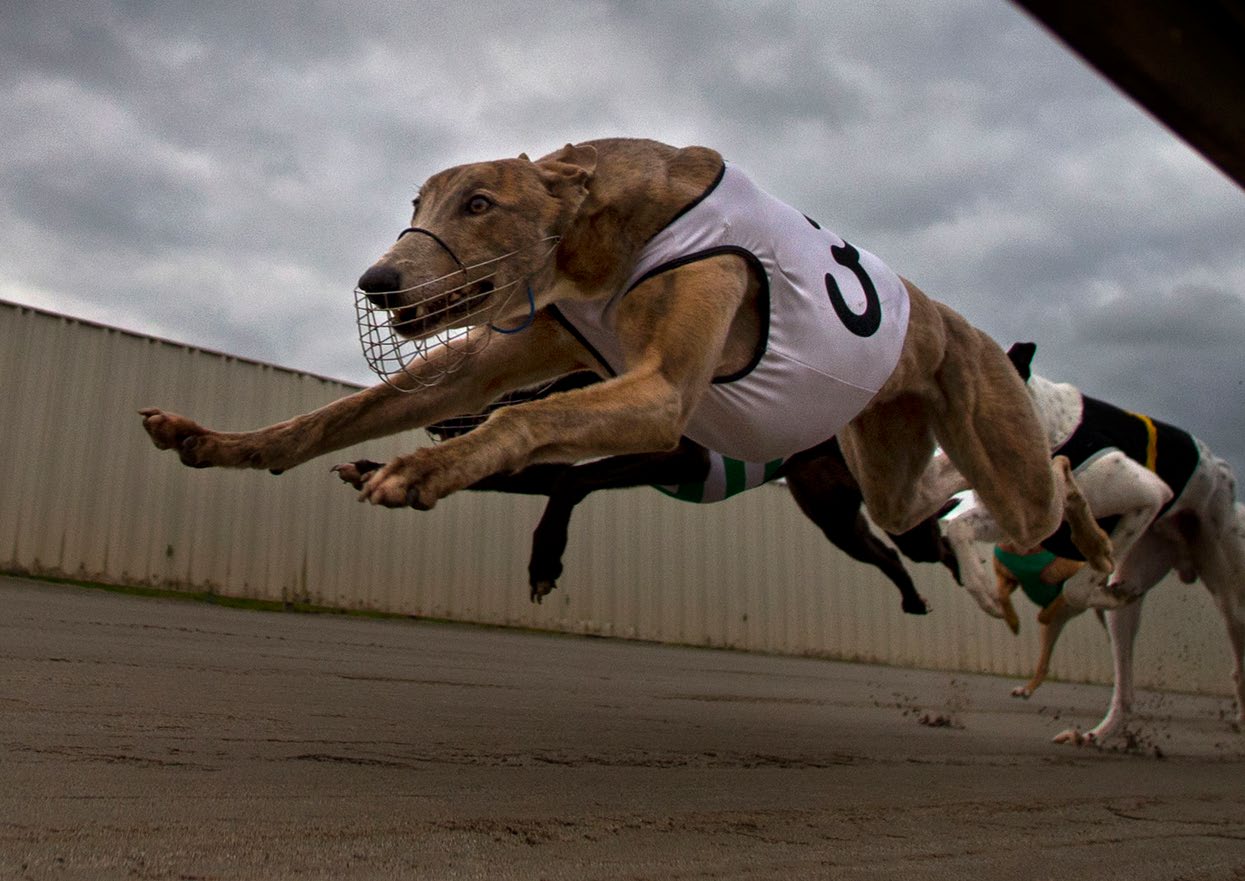
Greyhound racing at the Auckland Greyhound Club in Manukau. Photos: Brett Phibbs, NZME.
It’s race day in Palmerston North in June. Roughly two hours before the first race is set to get under way, trainers start to pull into the carpark towing flash, metres-long trailers adorned with racing stripes. On the track, a tractor pulls out towing several rows of broomheads and an array of tyres behind it, the equivalent of an ice rink’s Zamboni. It smooths out the track, minimising the chance of injury.
Malcolm Jansen, chief veterinary adviser for GRNZ, is standing inside a concrete-walled room resembling a rugby club changing room. Slowly, trainers bring their dogs in, leading them through a carefully orchestrated routine. The dogs get scanned for identity and weighed in a crate, before being led up a purpose-built ramp to stand at attention on a platform while a vet feels them all over to check for minor injuries that could progress to something worse.
The dogs are elegant — black, spotted or brown with doleful eyes and sharply angled faces. Their well-defined muscles ripple under their thin skin. “They’re like a walking anatomy lesson,” Jansen says.
Their anatomy has made them perfect for racing but also highly injury prone. Greyhounds have been selectively bred to be lean, muscular and light. Their distinctive running style gives them tremendous speed but relies on one of the hindlimbs doing the majority of the pushing — meaning it bears the brunt as a dog rounds a corner of the track. Twisting and pushing at high speed can lead to strained or sprained triceps and thigh ligaments or muscles, as well as dislocated or fractured joints.
Serious injuries include dogs suffering chunks of torn-off bone, or collapsed vertebrae from weakened spines. Fractured tarsal bones — the dog equivalent of an ankle bone — is one of the most commonly sustained serious injuries, needing surgery with plates and screws inserted to hold the bone together, and extensive physio afterward. If that doesn’t happen, dogs can be left with long-term pain and trouble walking. A tarsal bone fracture is often career-ending, but if trainers are willing to put the time and money into rehab, injured dogs can recover to live a normal life afterward — some will even return to racing. At the other end of the spectrum, a tarsal fracture can sometimes be so serious that the dog needs to be put down. According to the 2020 GRNZ annual report, during the 2019–20 racing season 34 dogs were euthanised due to race-day injuries.
Big injuries aside, a racing career can leave dogs with microscopic bone fractures that predispose them to full-on fractures later in life. This is partly the result of the track’s long, oval design, which requires dogs to round at least one bend per race. A bend too close to the starting line causes the dogs to bunch together in the lead-up to the turn. The dogs aren’t confined to their own lane and, unlike in horse racing, they are not directed by a jockey, so the animals jostle for position, bumping into each other. When travelling at close to 18 metres per second a slight bump can leave a dog in a heap.
Nine dogs died at a Whanganui racetrack in as many months, leading an animal rights group to call it it a “death track”.
There’s been a push to get the dogs running on a straight track or place the start line further from the first bend, and to use a lure with a longer arm to move dogs further away from the inside wall of the track. So far, only one track currently uses an extended arm lure and there are no straight tracks anywhere in the country.
Peters says it’s the responsibility of those in the industry to make sure there’s a structure that means the dogs are looked after properly. “What’s not understood by a lot of people who say they’re concerned [about animal welfare] is that . . . the animals they’re talking about love to run.”
Back in Palmerston North, the race-day commentary blares over loudspeakers, echoing off the near-empty stands. There are no spectators. The only attendees are the trainers and a multitude of officials, many of whom have their own greyhounds. It’s eerie and strange. Jansen tells me most of the viewers are at home or at the TAB, watching on TV.
When it’s finally time to race, the dogs come alive with energy. Trainers hold the leaping, yelping balls of fur at the edge of the track as the lure whirrs in front of them, winding them up. The dogs strain against their leads, desperately trying to get at the fluffy prey.
They are then led ceremoniously around the track and loaded into the starting boxes, individual metal crates lined up like a harmonica. Suddenly, the boxes clang open and a flurry of dogs emerges.
It’s on the track that you can see the dogs’ full, majestic size and power. Their bodies bend like a wave and their heads bob vigorously as they surge forward.
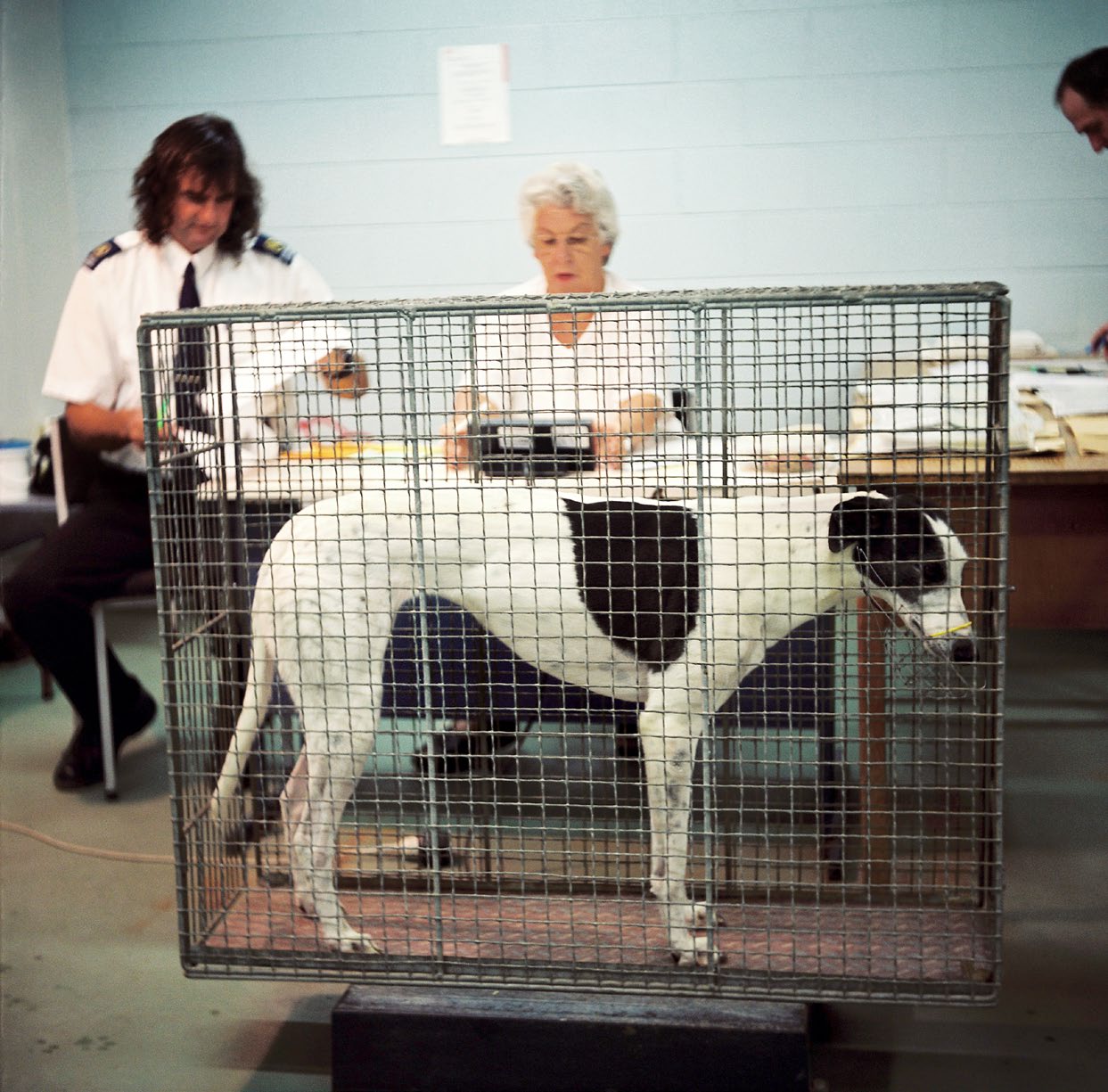
A greyhound being weighed before a race. Photo: Victoria Birkinshaw.
Right from the moment they’re born, greyhounds are on the path to racing. Few, if any, breeders outside the industry exist here. “If you close down the sport you close down greyhounds,” says GRNZ chief executive officer Glenda Hughes.
For the first year of their life, Fredrickson’s new greyhounds are put out in an exercise yard with their brothers and sisters. Then, puppies begin learning how to run, first on straight tracks and later on curved ones. They’ll spend their non-exercise time in separate kennels or going for walks.
At about 18 months old, right before they’re ready to race, the dogs get ‘turned out’ — meaning they spend a month inside in their kennels and are only let out to go to the toilet. This helps the training sink in and “lets their bones rest”, Fredrickson explains.
From there, dogs start racing once a week, followed by chill-out time and some practice runs at home. Before every race, they are kept in their own kennel for 48 hours to “bottle them up a bit”. This is their life for a couple of years, until the dogs retire at around the age of four. Ideally, they will then enter a rehoming programme to live out the rest of their lives as pets.
Fredrickson says rearing greyhounds in this way gets all their “youthful enthusiasm” out of them and you’re left with an unusual pet that people marvel at. “There’s a real win-win here. There’s people out there with friends for a lifetime. Without the industry they wouldn’t have that dog at all.”
Most major trainers have dozens of dogs — and some have as many as 100. Socialising the dogs isn’t at the top of the priority list. After all, how likely is a racing dog to encounter a toddler or bicycle on the track? But lack of socialisation is a major welfare issue. Socialisation is about setting the dogs up for success in their whole lives, explains New Zealand Veterinary Association chief veterinary officer Helen Beattie. That means not just getting puppies ready to race but to eventually be rehomed. Retired dogs that haven’t been socialised properly can be overly excitable, extra fearful or anxious, or, in extreme cases, pose a bite risk.
Someone who’s seen that all too well is Sian Tate, a veterinary nurse and retired-greyhound adopter. Her greyhound, Dyna, is a sleek, black dog often seen sporting a fuzzy, purple chequered coat. (The dogs wear the little coats partly for warmth but partly to protect their paper-thin skin, which is prone to nicks from the slightest snag.)
When I meet Tate at her rural home outside Palmerston North, Dyna quickly snuggles up next to me where she stays, unmoving, for the next half an hour. “She wouldn’t have done that when we got her,” Tate says. More than five years later, Dyna is braver, but still not good with public places and new people. “She’s not the sort of dog you could go to a café with,” Tate says.
Part of that comes down to her temperament, Tate says, but part of it is that she has barely experienced anything outside racing. People don’t realise the dogs haven’t spent a lot of time in houses. Things like stairs, vacuum cleaners or sliding doors can be quite terrifying for them.
Needing to rehabilitate or retrain these dogs creates bottlenecks in the greyhound rehoming programme. It also means there’s a greater chance that a dog will have trouble finding a suitable family. In previous years it’s also meant more euthanised dogs. Having said that, problems with rehoming seem to be trending downward, with more dogs entering the rehoming programme without the need for further retraining.
Yet SPCA scientific officer Alison Vaughan says GRNZ’s current welfare standards still don’t reflect current scientific understanding of animal welfare. It’s no longer just about making sure the animals are living in clean, dry, warm environments, getting good food and minimising injuries, stress or ill-health. Animal owners need to ensure they’re promoting a life worth living, Vaughan says — giving animals the opportunity to play, explore and make choices. In short, letting dogs be dogs.
This is not an impossible task. In 2019, thoroughbred racing updated its welfare guidelines in 2019 to reflect changing scientific knowledge. For a horse, that means paddocks where they can explore and forage for food, instead of barren stalls where they stand for hours on end. It means encouraging bonding between stockperson and horse, rather than a transactional relationship.
Many trainers see the time greyhounds spend in kennels as time to “chill out” after sprints. That may be the case, but the dogs also don’t have any other option.
Those in the industry insist that greyhound racing is the most highly regulated code in the country, and there are indeed plenty of rules imposed on both breeding and racing. There’s far less oversight on what goes on in the pet world, Fredrickson says. “If you were to go in a vet clinic for a week you’d probably be quite bloody horrified at the stuff that comes in those doors,” he says. “If a dog got injured or shot duck shooting, you’d never hear about it because it’s not on telly.”
Since 2020, all racing is overseen by the Racing Integrity Board, an independent body consisting of a retired judge, lawyers, a former farmer and a veterinarian with training in horses.
But progress on transparent reporting of data including injuries, euthanasia, the general health of the dogs and rehoming numbers has either stalled or never existed publicly in the first place. Race-day reports, which include winnings and some details of injuries, are available on GRNZ’s website if you know where to look. GRNZ stopped openly reporting more than a year ago, and the last report GRNZ provided in June 2020 contained “insufficient information” according to a letter from Associate Minister of Agriculture (Animal Welfare) Meka Whaitiri. She has asked the organisation to reinstate their reporting.
Hughes, on the other hand, is adamant that genuine progress is being made. She believes that the majority of the public are not opposed to greyhound racing, just a select, loud few. But independent reports say there’s currently little evidence to support those claims, due to GRNZ’s own underreporting.
Meanwhile, breeders like Fredrickson keep on setting their alarms early, loading their dogs into trailers and driving to races around the country. They keep tallying up their dogs’ wins and wondering how much longer to keep racing them. Keep raising the next generation of pups for their 14 minutes on the track. Why? “I need a reason to get out of bed in the morning,” Fredrickson says, gesturing to his dogs. “These are my reasons.”
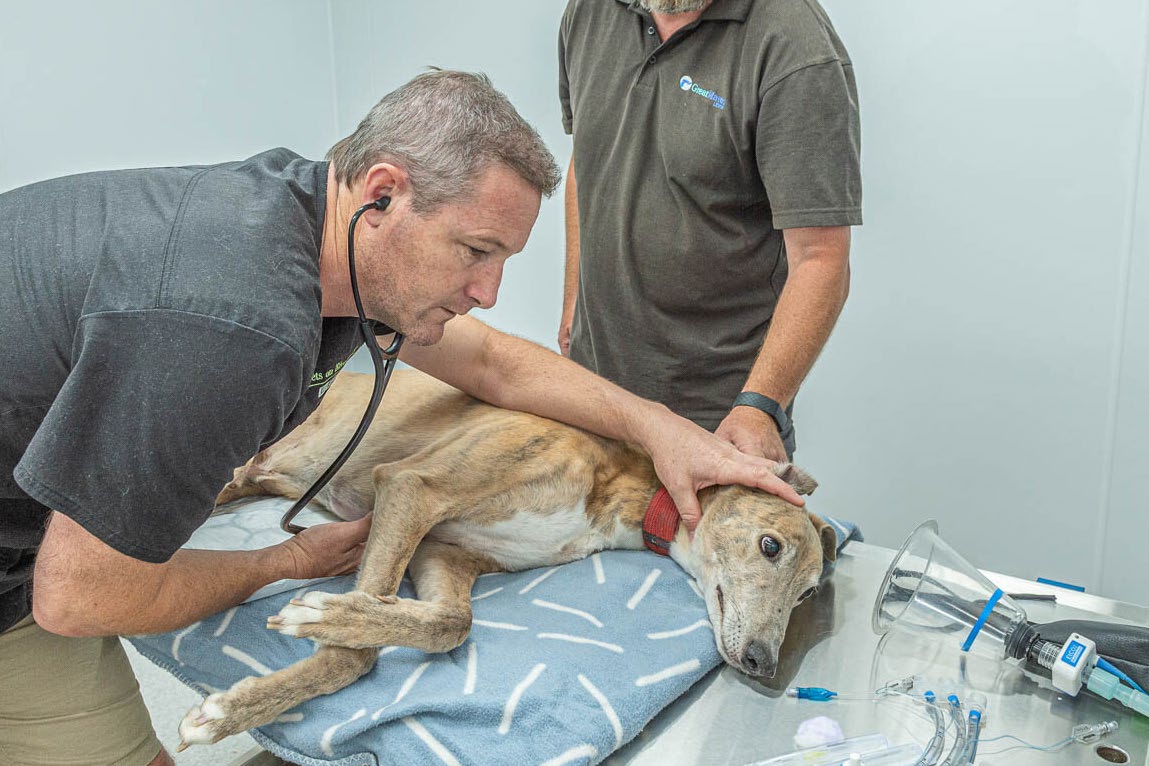
Great Mates in Levin is a greyhound rehoming programme. Kennel manager Anthony Stone observes as Charlie Georgetti, a veterinarian at Riverbank Vets, performs a health check to prepare the greyhound for adoption. Photo: Great Mates.
Mirjam Guesgen is a freelance science writer who writes on big topics like climate change, as well as mind-controlled machines, strange physics — and why every race horse has the same birthday.
This story appeared in the November 2021 issue of North & South.
